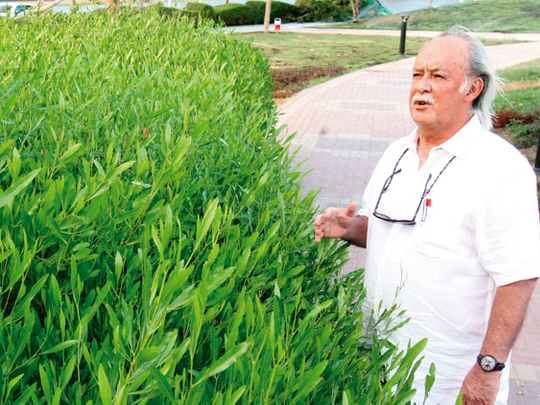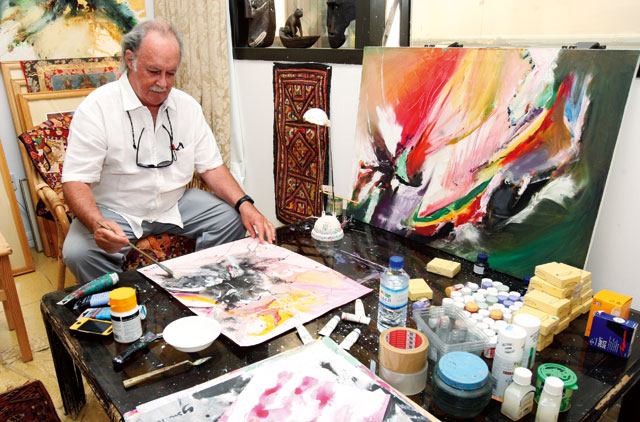
A winning formula of talent plus a large dose of passion has seen urban planner and landscape architect Robert Egan gain many plaudits. For 40 years Egan has been involved in creating complex, large-scale design projects around the world. The 65-year-old award winner is now also an accomplished fine artist.
He seeks to create designs that are both functional and sensitive to natural systems and community needs. The projects include residential, government facilities, highway corridors and educational facilities.
"When I see a possible space [for a structure], I think of the people who are going to use it," says Robert Egan who is currently a senior design management consultant with the Parks and Recreation Facilities Division (PRFD) at Abu Dhabi Municipality. "One needs to look at the optimum possibilities for the eventual users of the space - what is the project type, what is happening around it, how will it change over time and, of course, what is the potential three-dimensional image of it all?"
Egan has completed projects from small private designs to major schemes such as the 178km coastline plan in the East Coast National Scenic Area of Taiwan which comprised a comprehensive study of a complex and diverse coastline. He has planned, designed and managed projects almost all over the world.
However, says Robert, "of all project types, what gave me the most pleasure is the series of town redevelopment projects I was involved with in several towns and small cities in California... To go back and see several years later how that area has been renovated with smaller shops coming in and cafes opening up was ample proof of how design could actually influence the regeneration of a downtown."
Delivering on behalf of communities is a great joy, says Egan. "It is essential to understand how people enjoy space and what they truly want from it. Abu Dhabi Municipality has plans for several park projects and I am trying to organise workshops to bring the community together, see what they want and listen to them."
An Irish-American, Egan, who gained a Master's degree in Landscape Architecture from the University of Massachusetts in 1970, hails from New England in the northeast corner of the US. It was during the mid-80s while in California that another facet of his personality began to emerge. He had always liked to sketch and when he started playing around with colours, the drawings slowly began to take the forms of landscapes that he observed around him. Today, the worlds of the applied art of landscape architecture and fine art seamlessly synchronise in his life. "I cannot exit one and enter the other - I am in both of them."
His work is displayed in over 30 private collections and he has held several shows in the US and Taiwan. He is planning a UAE exhibition later this year.
I
I look upon landscape architecture as an applied art. There are many overlays of the applied art of design and fine art painting - one really helps the other and vice versa.
I arrived in the UAE in 2006 when I was beginning to tire of Beijing. I had been in and around China for more than 18 years, working through different eco-zones and soaking in the nation's diverse culture while doing several interesting projects all over the country. When a friend knew I was looking for a fresh place, he invited me to the UAE.
It was my first visit to a desert and I was taken aback at the developments I saw happening in Dubai. I had never seen anything in the world like this, happening on this large a scale and vowed to come back. Since then, I've worked on a large master plan in Tunisia, a five-kilometre project in Saudi Arabia, and the Kempinski Hotel in Beirut among others.
I visited Cityscape Abu Dhabi in April 2010 and was impressed by the model plan of Abu Dhabi's urban landscape showcased by the Abu Dhabi Urban Planning Council. The exhibitors referred me to the Municipality's Parks Recreation Facilities Division (PRFD) where I was soon offered a job although I was only looking for projects. The thought that I could be involved in all their upcoming projects was certainly very motivating.
Being in Abu Dhabi itself is phenomenal because there is no city which is becoming more culturally astute or culturally aware so rapidly. The PRFD is a very exciting place to be in especially as the Municipality is in a major transition mode and is currently moving on from the old-fashioned concepts of landscape design to newer, fresh ideas.
I am a firm believer in the notion of well begun is half done. Any design project begins with listening intently to the client. Then I visit the site with the client, walk it, kick the dirt, feel it, and understand the dynamics of the economy of what is occurring around that site and in the region.
I discuss a lot; look at the various possibilities, the client's dreams - and the realities of his dreams. We look at alternative schemes even before drawing anything.
I like to go back to a space where I have participated in the design and ask the users where the problems lie in the use of that space. This is something I often do - go back, and see the reality, not walk away from something I have done. Every design has problems in the product. And if you can pick up on what you have missed and not miss it the next time, it will make a huge difference.
I will never forget the birthday present my great friend and business partner, Lynn Pomeroy, once gave me. He had seen me read a book and study the techniques of an English artist named John Blockley who, I think, was one of the great English watercolour artists of all time. Lynn gave me a birthday gift for a place in one of Blockley's painting workshops in St Davids, Wales, including the air ticket. There were 15 of us at the workshop, and that really was the kicker that made me more devoted to painting.
I am nostalgic about the six-month overland trip I took from Istanbul to Bangladesh back in 1973 travelling through Turkey, Iraq, Iran, Afghanistan, Pakistan, India and Bangladesh. I met some of the greatest people in my life and saw an astounding range of indigenous architecture on that trip.
I am inspired by music. I enjoy Bach, all forms of Indian music, Bob Marley, the Rolling Stones, African music, Katie Melua, The Rat Pack, BB King, Johnny Cash, Irish ballads, and Sufi music.
Amongst artists, I am inspired by the masters such as Leonardo Da Vinci, Gauguin, Picasso and John Blockley. I am also enthralled by Robert Rauschenberg and my friend Chuang Che, who I feel is the greatest living Chinese abstract painter.
Me
Me and my design philosophy: I love contemporary, modern stuff but only on an overlay of sensitivity to the existing place. One thing I do not really care for is trying to recreate another time or another place today. I love using technology in simple but artistic ways to respect what is there and blend with it.
Me and my architectural influences: Some of the great designers I admire are Peter Walker, under whom I worked for a year, Frank Gehry, Pritzker winning Zaha Hadid, and Frederick Law Olmsted, the father of landscape architecture. American landscape architects Lawrence Halprin and Hideo Sasaki were also a huge influence on me as was my friend and partner Lynn Pomeroy and his architect brother Leason Pomeroy.
Perhaps the most important architectural influence I've had is from architecture without architects - indigenous architecture - that nobody has been trained to design but which becomes the fabric of towns and villages. I find it incredible that they have such a great understanding of people and spaces. Wherever I've travelled, seeking out vernacular architecture has been my greatest magnet be it in Rajasthan, India, the Greek islands or the villages of China.
Me and the most frustrating/rewarding part of my work: The most frustrating part is periodically having to deal with people who have programmed thinking - black and white, either/or thinking. And the most pleasurable is sharing a vision with people. Whether it is with a client, colleagues or stakeholders, the collective energy starts to become very strong.
Me and my goals for the future: I am just beginning to think about the Caribbean Coast of Colombia as a potential next stop on the journey. This is probably due in no small part to the writings of Gabriel Garcia Marquez. His descriptions of the Colombian landscape are so emotionally delicious. The city of Cartagena especially intrigues me.
Me and my best-kept secret: I would like to write a book for school students on landscape architecture so they will begin to understand that they are stepping into a magical world and that their new profession can take them anywhere. There is no right or wrong in this idea. Many of my dear friends have stayed on in Boston and have led fantastic lives. But those who have the rumbles really have to take the bite - I am just so fortunate it happened to me.
Myself
How does landscape architecture contribute to society? Landscape is not a garden but it is everything that we see on the land outside of a building footprint - the roads, the sidewalk, public spaces, natural landscape, parks and waterways, river edges, islands. Today with buildings also becoming greener, the combination of architecture and landscape becomes very important to the world - not just for its aesthetic beauty but also for linking physical spaces together, making them practical.
The main current landscape architecture trends are... the integration of the landscape into the built environment. That trend stems from the continual growth and understanding of how contemporary landscape architects view the nature of open space.
My attitude of the current trend is that my glass is more than half full because some of the work being done now is really very good. People are thinking more, the world is becoming smaller, we are getting closer together and people are travelling and understanding countries - this planet is now vibrating in terms of landscape design.
How practising art influenced my design techniques: By helping me to see my design work as if I am walking through a painting. It is not about the canvas or watercolour or oils and acrylic, it has to do with edges, colour, transition, texture - just as it is in a painting. The elements are all there; it is just that one is on the ground and one is on the canvas.
Does landscape architecture bridge the divide between cultures? Yes. (My work) has taken me all around the world with projects in so many different situations and cultures, with varied budgets, schedules and clients - some of whom did not even speak the same language!
While working in different cultures, the design process often becomes quite intense. This is shared with both clients and colleagues and in that sense landscape architecture is a great bridge provider.
Inside info
Robert Egan can be contacted on roberten2000@yahoo.com. He does private painting commissions












